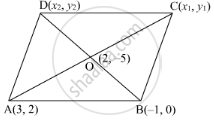Advertisements
Advertisements
प्रश्न
If two adjacent vertices of a parallelogram are (3, 2) and (−1, 0) and the diagonals intersect at (2, −5), then find the coordinates of the other two vertices.
उत्तर
Let ABCD be the parallelogram with two adjacent vertices A(3, 2) and B(−1, 0). Suppose O(2, −5) be the point of intersection of the diagonals AC and BD.
Let C(x1, y1) and D(x2, y2) be the coordinates of the other vertices of the parallelogram.

We know that the diagonals of the parallelogram bisect each other. Therefore, O is the mid-point of AC and BD.
Using the mid-point formula, we have
\[\left( \frac{x_1 + 3}{2}, \frac{y_1 + 2}{2} \right) = \left( 2, - 5 \right)\]
\[ \Rightarrow \frac{x_1 + 3}{2} = 2\ and\ \frac{y_1 + 2}{2} = - 5\]
\[ \Rightarrow x_1 + 3 = 4\ and\ y_1 + 2 = - 10\]
\[ \Rightarrow x_1 = 4 - 3 = 1\ and\ y_1 = - 10 - 2 = - 12\]
So, the coordinates of C are (1, −12).
Also,
\[\left( \frac{x_2 + \left( - 1 \right)}{2}, \frac{y_2 + 0}{2} \right) = \left( 2, - 5 \right)\]
\[ \Rightarrow \frac{x_2 - 1}{2} = 2\ and\ \frac{y_2}{2} = - 5\]
\[ \Rightarrow x_2 - 1 = 4\ and\ y_2 = - 10\]
\[ \Rightarrow x_2 = 4 + 1 = 5\ and\ y_2 = - 10\]
APPEARS IN
संबंधित प्रश्न
In what ratio does the x-axis divide the line segment joining the points (2, –3) and (5, 6)? Also, find the coordinates of the point of intersection.
Find the coordinates of the points which divide the line segment joining A (−2, 2) and B (2, 8) into four equal parts.
If two vertices of a parallelogram are (3, 2) (-1, 0) and the diagonals cut at (2, -5), find the other vertices of the parallelogram.
Find the distance of the point (1, 2) from the mid-point of the line segment joining the points (6, 8) and (2, 4).
Calculate the ratio in which the line joining the points (–3, –1) and (5, 7) is divided by the line x = 2. Also, find the co-ordinates of the point of intersection.
Calculate the ratio in which the line joining A(6, 5) and B(4, –3) is divided by the line y = 2.
Find the co-ordinates of the points of tri-section of the line joining the points (–3, 0) and (6, 6).
Find the length of the hypotenuse of a square whose side is 16 cm.
Find the ratio in which the line x = O divides the join of ( -4, 7) and (3, 0).
Also, find the coordinates of the point of intersection.
Find the coordinates of the point R on the line segment joining the points P(–1, 3) and Q(2, 5) such that PR = `3/5` PQ.
